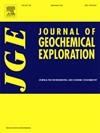Health risks due to geogenic and anthropogenic influences on groundwater quality in Southern India's hard rock terrain
IF 3.3
2区 地球科学
Q1 GEOCHEMISTRY & GEOPHYSICS
引用次数: 0
Abstract
Groundwater contamination poses a critical public health risk in Raichur district, Karnataka, India where groundwater is a vital resource for drinking and agriculture. A total of 54 groundwater samples were analyzed, revealing that 68.5 % exceeded the WHO's nitrate limit of 45 mg/L, with concentrations ranging from 2.2 mg/L to 830 mg/L, and 44.4 % surpassed the fluoride threshold of 1.5 mg/L, with levels ranging from 0.06 mg/L to 7.18 mg/L. A comprehensive Health Risk Assessment (HRA) identified infants, children, pregnant women, and lactating mothers as vulnerable populations, with Hazard Quotient (HQ) values reaching 67.25 for nitrate and 23.33 for fluoride. These elevated levels indicate significant risks, including methemoglobinemia and skeletal fluorosis. Geospatial analysis mapped contamination hotspots in the northern and central regions, highlighting the interplay of anthropogenic activities like excessive fertilizer use, inadequate waste management, and natural geological factors. Recommendations include precision farming, improved waste management, and community-level remediation systems, such as defluoridation and denitrification technologies. Artificial groundwater recharge and regulatory interventions are critical to maintaining water quality. By integrating geospatial tools and HRA, this study provides a replicable framework for addressing groundwater contamination and ensuring sustainable water resource management, particularly in regions with similar hydrogeological challenges.
印度南部坚硬岩石地形中地质和人为对地下水质量影响的健康风险
地下水污染对印度卡纳塔克邦Raichur地区的公众健康构成严重威胁,该地区的地下水是饮用水和农业的重要资源。对54份地下水样本进行了分析,结果显示,68.5%的地下水样本硝酸盐含量超过世界卫生组织规定的45 mg/L限值,浓度范围为2.2 ~ 830 mg/L; 44.4%的地下水样本氟含量超过1.5 mg/L限值,浓度范围为0.06 ~ 7.18 mg/L。综合健康风险评估(HRA)将婴儿、儿童、孕妇和哺乳期母亲确定为弱势群体,硝酸盐的危害商(HQ)值达到67.25,氟化物的危害商(HQ)值达到23.33。这些升高的水平表明存在重大风险,包括高铁血红蛋白血症和氟骨症。地理空间分析绘制了北部和中部地区的污染热点,突出了肥料过度使用、废物管理不足和自然地质因素等人为活动的相互作用。建议包括精准农业、改进废物管理和社区一级的补救系统,如除氟和反硝化技术。人工地下水补给和监管干预对维持水质至关重要。通过整合地理空间工具和HRA,本研究为解决地下水污染和确保可持续水资源管理提供了一个可复制的框架,特别是在具有类似水文地质挑战的地区。
本文章由计算机程序翻译,如有差异,请以英文原文为准。
求助全文
约1分钟内获得全文
求助全文
来源期刊

Journal of Geochemical Exploration
地学-地球化学与地球物理
CiteScore
7.40
自引率
7.70%
发文量
148
审稿时长
8.1 months
期刊介绍:
Journal of Geochemical Exploration is mostly dedicated to publication of original studies in exploration and environmental geochemistry and related topics.
Contributions considered of prevalent interest for the journal include researches based on the application of innovative methods to:
define the genesis and the evolution of mineral deposits including transfer of elements in large-scale mineralized areas.
analyze complex systems at the boundaries between bio-geochemistry, metal transport and mineral accumulation.
evaluate effects of historical mining activities on the surface environment.
trace pollutant sources and define their fate and transport models in the near-surface and surface environments involving solid, fluid and aerial matrices.
assess and quantify natural and technogenic radioactivity in the environment.
determine geochemical anomalies and set baseline reference values using compositional data analysis, multivariate statistics and geo-spatial analysis.
assess the impacts of anthropogenic contamination on ecosystems and human health at local and regional scale to prioritize and classify risks through deterministic and stochastic approaches.
Papers dedicated to the presentation of newly developed methods in analytical geochemistry to be applied in the field or in laboratory are also within the topics of interest for the journal.
 求助内容:
求助内容: 应助结果提醒方式:
应助结果提醒方式:


